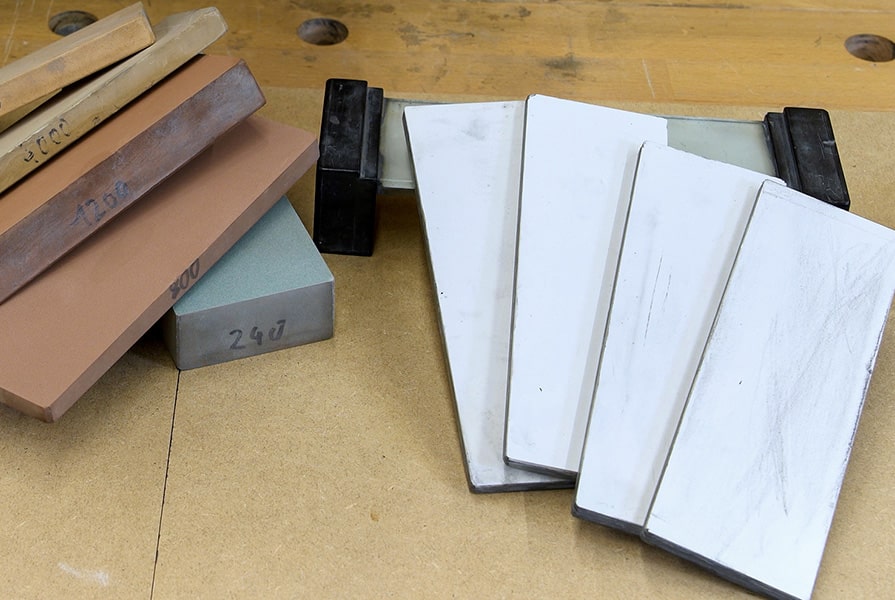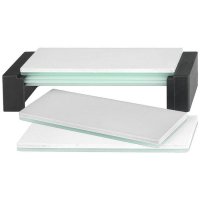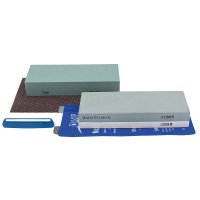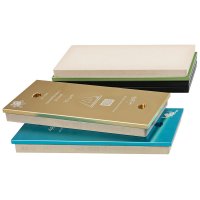
How are synthetic sharpening stones constructed?
Synthetically produced sharpening stones consist of the abrasive particles that remove material from the blade and the »matrix«, a binding agent that holds the abrasive particles together.
The abrasive particles can be artificially produced or come from natural sources. This is the reason why we generally speak of »synthetic« stones rather than »artificial« stones. The abrasive particles used can be aluminium oxide, carbides, diamond dust and natural semi-precious stones.
Clay-like substances are used as binders, their hardness is determined by their composition and the level of the firing temperature. The effectiveness of a sharpening stone depends on the combination of the hardness of the binder and the quality of the abrasive particles.
What is the »bond« of sharpening stones?
With sharpening stones, the term »bond« refers to the property of how quickly the abrasive particles are released. During sharpening, the sharp edges of the abrasive particles are worn away. In addition, the metal grindings of the blade collect between the particles. In order to continue sharpening effectively, worn abrasive particles must be released from the bond so that the abrasive particles underneath with sharp edges can come to the surface of the stone.
An optimum bond is achieved when only blunted abrasive particles are released from the surface. However, the different abrasive particle materials wear out at different rates. Most Japanese waterstones use silicon carbide and corundum abrasives and have a rather soft, open-pored bond that continuously brings fresh abrasive particles to the surface during sharpening and thus is highly effective. Ceramic stones, on the other hand, usually have a very hard bond and little wear. In order to still achieve a good sharpening performance, they need to be equipped with very high-quality and wear-resistant abrasive particles, such as high-grade corundum or aluminium oxide. In the extreme case of a completely rigid bond, and thus creating an almost wear-free sharpening tool, diamond or cubic boron nitride (CBN) is used as the abrasive.
What are the advantages and disadvantages of a soft bond?
When sharpening on a bench stone with a softer bond, you work the worn abrasive particles out of the stone more quickly. There are always sharp-edged abrasive particles on the surface of the stone, which ensure effective material removal. However, stones with a softer bond will become uneven more quickly and you will need to true them more often.
What are the advantages and disadvantages of a hard bond?
The advantage of a harder bond is that the stone remains flat for longer. You don't have to true it so often. A hard bond releases the worn abrasive particles more slowly, material removal can slow down and clog the surface of the stone.
Which bond is suitable for which type of steel?
As a rule of thumb for bond selection: Soft steel is sharpened on hard bond stones and hard steel is sharpened on soft bond stones.
Accordingly, high-quality Japanese knives with a low-alloy carbon steel blade, for example, are best sharpened on a waterstone with a soft bond. For Western chisels and plane blades, on the other hand, the blades of which are usually made of a comparatively high-alloy steel (e.g. chrome/vanadium, HSS), harder bonded sharpening stones.
But as always, exceptions prove the rule. The hard-bonded Shapton® Glass Stones, for example, are very versatile.
Which synthetic abrasives are available?
Corundum/Aluminium oxide
Natural corundum is a very hard mineral, close in hardness to diamond. Due to the great demand, corundum has been produced synthetically since the 19th century under the name »aluminium oxide«. A distinction is mainly made between two degrees of purity:
Corundum (brown standard corundum) with a purity of 94 % and
High-grade corundum (white aluminium oxide) which has a purity of almost 100 %
The higher the purity, the harder and more brittle the abrasive. Metal oxides are often added to achieve higher toughness.
Silicon carbide The crystals of silicon carbide are significantly more brittle than those of corundum and are particularly sharp-edged. Due to its shape, silicon carbide has very good removal properties and is preferred for coarse grit sizes. Its hardness is not as high as corundum, but still very close to the hardness of diamond. Green silicon carbide is the toughest and purest form of silicon carbide.
Industrial diamond: These are artificially produced diamonds and not natural gemstones. While real diamonds take several thousand years to develop, industrial diamonds are usually produced in just a few weeks using a HPHT (high pressure, high temperature) process. Diamond is considered the hardest material in the world.
CBN (cubic boron nitride): Similar to diamonds made from graphite, CBN (also β-boron nitride) can be artificially produced from α-boron nitride under high temperatures and high pressure. Its hardness is equal to that of diamonds. However, CBN is much more suitable for sharpening hardened steel.




